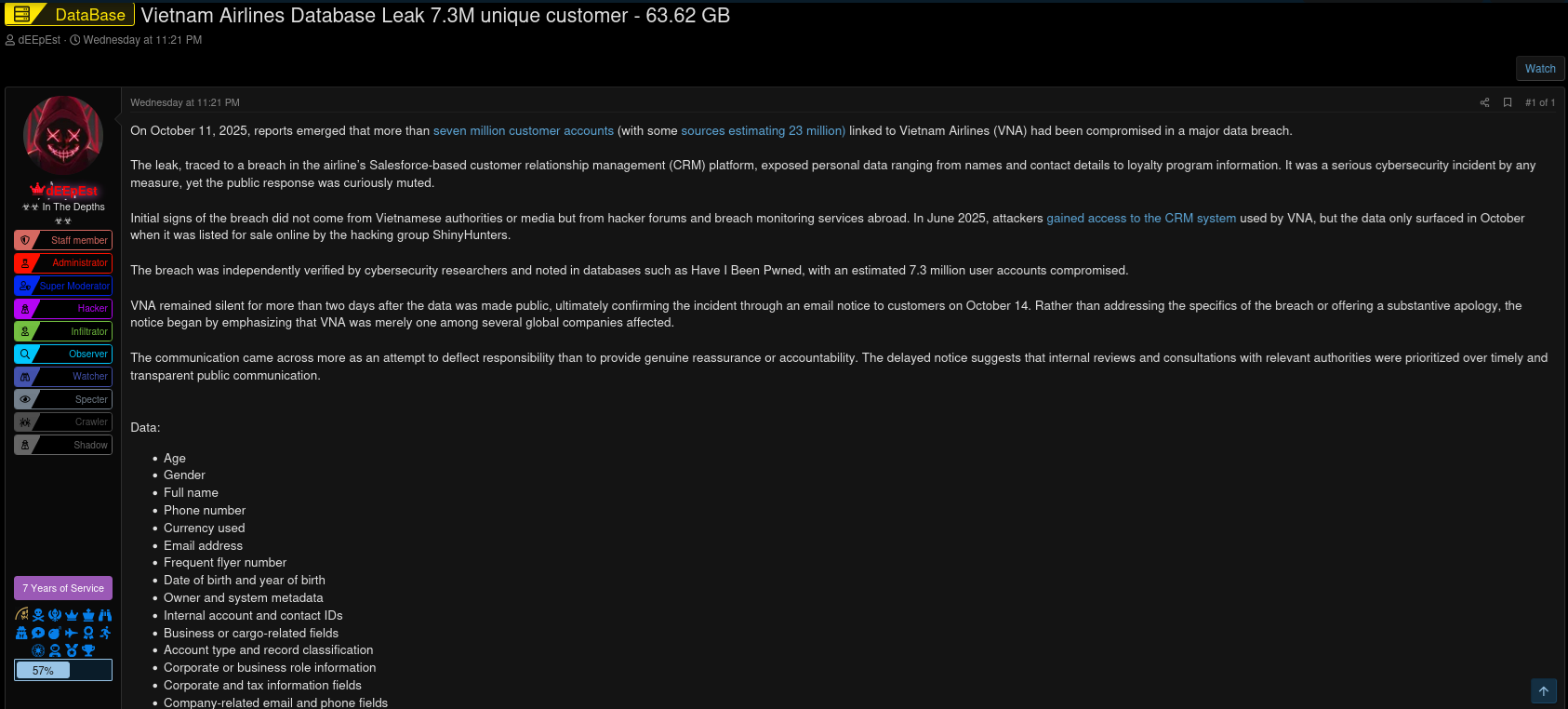Vietnam Airlines Data Breach Revealed: Key Details, Timeline and Impact

➤Summary
The Vietnam Airlines data breach has quickly become one of the most talked-about cybersecurity incidents of 2025. During a routine sweep of underground forums, the Kaduu team discovered a large database posted on the dark web that allegedly contains sensitive passenger information. The post appeared on htdark.com, authored by the user “dEEpEst”, dated October 14 2025. Investigations suggest that the initial intrusion occurred around June 2025, resulting in the exposure of millions of customer records. 🕵️♀️
This alarming Vietnam Airlines customer data leak 2025 once again highlights how vulnerable global aviation systems are when third-party service providers fail to maintain strong data-protection measures.
How the Vietnam Airlines Database Was Discovered
During a regular monitoring session on dark-web and deep-web marketplaces, the Kaduu Cyber Threat Intelligence team identified a new thread titled:
“🔥 VietnamAirlines 2025 FULL DB – 23M Records 🔥”
The listing appeared on htdark.com, a well-known underground forum. The post was authored by a hacker using the alias “dEEpEst”, who claimed responsibility for obtaining the Vietnam Airlines database through a CRM vulnerability. Kaduu analysts quickly verified a subset of the leaked sample and confirmed it contained legitimate customer data.
📸 [Screenshot: Forum post]

This discovery was later cross-referenced with independent cyber threat intelligence platforms and confirmed by several open-source databases, including Have I Been Pwned and Vietnam Airlines’ own public statement released on October 14 2025.
Timeline of the Cybersecurity Incident
| Date | Event |
| June 2025 | Breach occurs via third-party CRM system used by Vietnam Airlines. |
| July – Sept 2025 | Data quietly circulates among private threat groups. |
| October 14 2025 | Database posted publicly on htdark.com by dEEpEst. |
| October 15 2025 | Kaduu team confirms authenticity and reports findings. |
| October 18 2025 | Vietnam Airlines issues official acknowledgment. (Official Statement) |
What Data Were Compromised? 🧾
Analysis of the database suggests that personal identifiable information (PII) was compromised, although payment and passport data remain safe.
Leaked information includes:
- Full names of passengers
- Email addresses and phone numbers
- Dates of birth
- Loyalty programme (Lotusmiles) membership IDs
- Travel history metadata and airport codes
- Corporate account details (for business clients)
According to Asia Times, the exposed data covers a five-year period between 2020 and 2025. Vietnam Airlines has assured that no credit-card or passport details were leaked, but the data remains valuable for identity theft and phishing scams. 💳
Who Was Behind the Attack?
Attribution in cybercrime is complex, but several reports link the breach to a hacker collective known as Scattered LAPSUS$ Hunters, connected to the infamous ShinyHunters network. Security research from Outpost24 reveals that the attackers exploited vulnerabilities in CRM or Salesforce-based systems used by multiple companies in the region.
The Vietnam Airlines data breach seems to be part of this larger campaign, where attackers gain access to partner systems, exfiltrate sensitive records, and sell or publish them on dark-web forums if ransom demands aren’t met.
Impact on Customers and the Airline 😟
This cybersecurity incident has far-reaching consequences:
- Customer Trust: Millions of passengers could face targeted scams and spam.
- Financial Risk: Stolen information may be used in social-engineering attacks.
- Regulatory Oversight: Vietnam Airlines may face compliance investigations under global privacy laws.
- Operational Disruption: Security audits and reputational repair consume major resources.
As cybersecurity expert Linh Tran (CyberAsia Lab) commented:
“This breach shows the domino effect of third-party vulnerabilities. Even top-tier airlines must reassess supplier security controls.”
Expert Insight and Industry Reaction 💬
Cybersecurity professionals stress that this incident emphasizes the growing danger of third-party data exposure. Airlines increasingly rely on cloud-based CRM platforms for managing customer information. A single misconfigured API or leaked credential can lead to large-scale breaches.
In an interview with Darknet Search, a Kaduu researcher noted:
“The breach did not stem from Vietnam Airlines’ internal systems but from an external partner. The airline responded quickly after the public disclosure.”
For readers wanting technical details, you can explore internal resources such as DarknetSearch.com — Airline Breach Reports and DarknetSearch.com — Threat Actor Profiles.
Practical Tip: How to Protect Your Personal Data 🧠
If you suspect your information was compromised in the Vietnam Airlines data breach, follow this checklist:
✅ Change your password immediately and enable 2FA.
✅ Avoid clicking on suspicious links in “airline refund” emails.
✅ Monitor loyalty-programme transactions and credit statements.
✅ Verify all airline communications through official channels.
✅ Use breach-notification tools like Have I Been Pwned to check exposure.
These actions significantly reduce your risk of falling victim to identity fraud or targeted scams.
Why the Breach Matters to the Aviation Industry ✈️
The Vietnam Airlines customer data leak 2025 highlights the urgent need for airlines to invest in airline data security. Aviation companies handle enormous amounts of personal data: travel itineraries, ID numbers, and payment details. The attack demonstrates that even if one supplier is compromised, the ripple effects can be global.
In 2025 alone, cyberattacks on travel companies rose by 38%, according to industry reports. The Vietnam Airlines breach underscores how the dark web has become a marketplace for sensitive aviation data.
Frequently Asked Question ❓
Was my passport or payment data stolen in this cybersecurity incident?
➡️ No. Vietnam Airlines confirmed that payment, password, and passport details remain secure. Only contact and loyalty data were involved.
Checklist for Organizations to Prevent Future Breaches 🧩
- Conduct regular third-party risk assessments.
- Implement zero-trust architecture for partner access.
- Encrypt customer records and mask PII in transit and at rest.
- Require vendors to maintain SOC 2 or ISO 27001 certification.
- Use automated dark-web monitoring like Kaduu does.
These steps drastically reduce exposure and build resilience against future data leaks.
The Broader Picture: Trust and Transparency 🌐
Every data leak erodes consumer confidence. The Vietnam Airlines data breach has become a case study in how quick detection and transparent disclosure can mitigate reputational damage. The company’s prompt response and cooperation with authorities show that open communication is critical in managing a cybersecurity incident.
However, experts warn that reactive measures are no longer enough. Proactive, predictive cybersecurity backed by AI-driven threat detection and responsible data-handling policies are now industry necessities.
Conclusion 🚀
The Vietnam Airlines data breach serves as a powerful reminder of how interconnected the digital world has become. When one partner fails, millions of users can suffer. For passengers, vigilance and cybersecurity hygiene remain the best defenses. For companies, constant monitoring and third-party risk audits are non-negotiable.
✈️ Discover much more in our complete guide on DarknetSearch.com — Data Breach Reports
🛡️ Request a demo NOW
Your data might already be exposed. Most companies find out too late. Let ’s change that. Trusted by 100+ security teams.
🚀Ask for a demo NOW →Q: What is dark web monitoring?
A: Dark web monitoring is the process of tracking your organization’s data on hidden networks to detect leaked or stolen information such as passwords, credentials, or sensitive files shared by cybercriminals.
Q: How does dark web monitoring work?
A: Dark web monitoring works by scanning hidden sites and forums in real time to detect mentions of your data, credentials, or company information before cybercriminals can exploit them.
Q: Why use dark web monitoring?
A: Because it alerts you early when your data appears on the dark web, helping prevent breaches, fraud, and reputational damage before they escalate.
Q: Who needs dark web monitoring services?
A: MSSP and any organization that handles sensitive data, valuable assets, or customer information from small businesses to large enterprises benefits from dark web monitoring.
Q: What does it mean if your information is on the dark web?
A: It means your personal or company data has been exposed or stolen and could be used for fraud, identity theft, or unauthorized access immediate action is needed to protect yourself.
